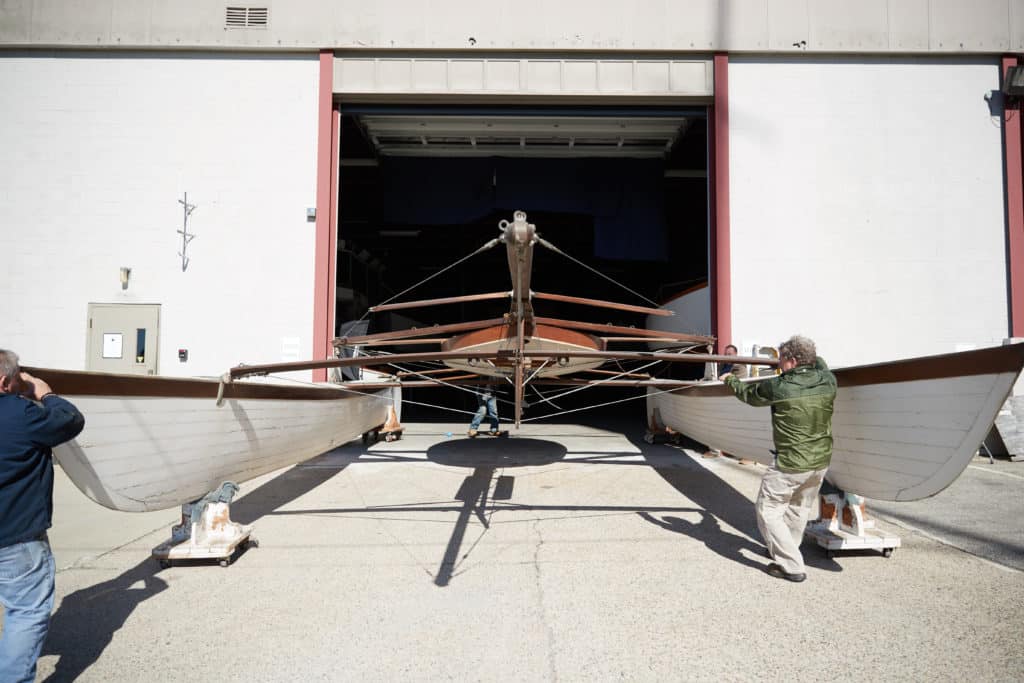
Sure, the America’s Cup class cats are leading edge. But Capt. Nathanael G. Herreshoff made it cool 140 years ago.
Patent No. 189,459 — filed on April 10, 1877 by Herreshoff — states that his design is one that “can obtain great speed and stability, with safety and comfort … I employ two hulls, each of a proper model, held at considerable distance apart, parallel to each other. A peculiar frame-work connects the hulls and supports the deck and mast or masts.”
Herreshoff designed Amaryllis after spending a lot of time thinking about the relationship between speed, power and stability. In a letter to the editor of the New York Herald, he wrote: “There are two important principles of speed which constantly work against each other. If we increase the power to get more speed, we must increase the stability of the hull correspondingly. An increased hull has more resistance ….”

After drawing numerous approaches, Herreshoff wrote: “I kept on following this principle, getting the keel higher and higher until, by and by, the keel came out of the water, when, lo and behold! There was the double boat! Nothing else to be done but take a saw and split her in two, spread it apart a little way, and cover all with a deck, and there you are!”
On-water testing was initiated with a model that was so fast, Herreshoff had a hard time catching it in his dinghy. Herreshoff built the hulls of Amaryllis to be 24 feet long and 20 inches wide. Its sloop-rigged mast stands 27 feet tall.
While the craft was unconventional, its speed was indisputable. At its first regatta, the New York Yacht Club’s Centennial Regatta, Amaryllis won line honors but was subsequently disqualified for being “not a yacht.”
No matter — the Wizard of Bristol had made his point. Not only was Amaryllis fast, but the design was also comfortable. Herreshoff wrote: “There is no shifting of ballast, no hanging on with tooth and nails up to windward. I am sure that a half day’s sail in the Amaryllis would spoil anyone for the old-fashioned sailing.”
Capt. Nat’s grandson, Halsey Herreshoff, agrees. He believes Capt. Nat would be “delighted” by today’s America’s Cup catamarans. He notes that “the most interesting thing is the ratio of the beam to length is about the same as what Captain Nat came up with in 1875. It’s not so much the same as copying; I’d say it’s more like two different engineers coming up with the same good solution.”

Modern experts believe that Herreshoff was ahead of his time. “For Herreshoff to build such a lightweight and high-performance catamaran, he had to develop some new and innovative structural concepts,” says Pete Melvin, a partner in Melvin & Morrelli Design & Engineering. “Amaryllis was built with truss structures made up of tapered wood spars and steel cables. This held the hulls together, and supported the mast and standing rigging. You can see similar structural concepts on today’s highest-performance multihulls, including America’s Cup catamarans.”
Melvin goes on to explain: “While most modern multihulls are designed to be stiff, Herreshoff realized that making Amaryllis’ structure stiff would create higher loads and require heavier structural components. He intentionally allowed some of the connections between truss members, hulls and rig to freely rotate. The synthesis of lightweight construction and low-drag hull shapes created what many consider to be the first modern high-performance catamaran.”
Bill Lynn, the executive director of the Herreshoff Museum, says, “Herreshoff patented the modern catamaran in 1877, and he dominated the America’s Cup for over 40 years from 1893 until 1934.” Could we call him the father of the modern AC? “I’m not sure all of his fans would think that’s a good thing,” says Lynn. But, he’s pretty convinced Capt. Nat would happily take a foiling AC50 for a spin.









